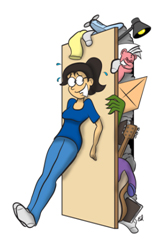 WordPress makes it very easy to add media (photos, PDFs, Word docs, etc.) to your site with the Add Media button.
WordPress makes it very easy to add media (photos, PDFs, Word docs, etc.) to your site with the Add Media button.
Like many cloud storage programs, WordPress stores the media files in a separate area from the content. This can create an “out of site, out of mind” pile of files in the Media Library.
The older your site grows, the bigger the Media Library. If you keep adding media, eventually it will grow into a junk closet situation where you dread the cleanup process, and may even upload additional copies of files to avoid digging through the big pile of existing files.
The following tips will help prevent the problem and to make the cleanup less painful.
- Upload a media file once and reuse it in multiple pages and posts. This saves a ton of space and clutter in the Media Library.
- When you need to delete a media file, start in the Media Library and look at the places the file has been inserted (see instructions below on Media File cleanup). Once you know the location of the inserted files, then delete the original from the Media Library, and edit each page and post to remove the inserted files.
- If you need to update a media file, use the instructions above re deleting files.
- Give meaningful names to media files before you upload them to WordPress. Consider what would be a meaningful name when you review the Media Library six months or a year from now. Do not include spaces or punctuation (except underscores or dashes) in the filename. Once you’ve uploaded the file to the Media Library, you can add a description that visitors won’t see.
- Downsize the file BEFORE you upload it to WordPress. The file resolution should not be greater than 72ppi, and the width should be about 300px maximum. Banner images are the exception. The site http://webresizer.com/ lets you downsize the files without additional software like Adobe Photoshop.
- One media file can appear in several places, but deleting one does not remove all the copies. You have to find all the copies and delete them individually.
- Understand that the media file original is always stored in the Media Library – not inside the page or post like Microsoft Word. Deleting the link to the media file, or the photo, from inside a page or post does NOT remove the copy from the Media Library, or from other pages or posts. To delete the media file, you must delete it from the page or post and from the Media Library. The Media Library can show you the names of the other pages and posts which use the file, to help avoid broken links.
- Outdated and duplicate copies of media files can turn up in searches within your site, and also visitors coming from the search engines (Google, Bing, Yahoo, etc.). This means people can stumble across outdated or incorrect information out of context and not realize the information isn’t cu
- Before uploading a media file, check the Media Library to see if it already exists on the site.






